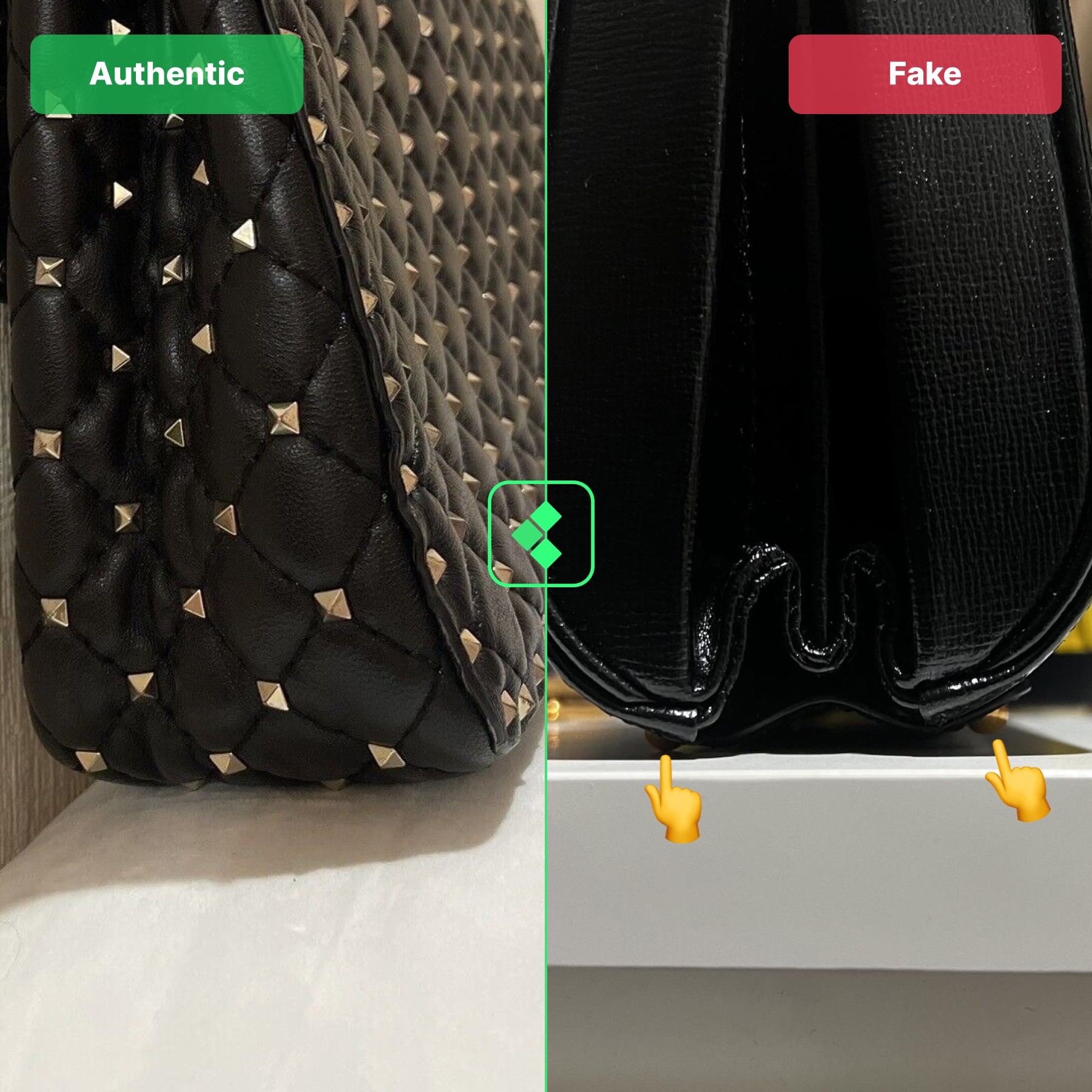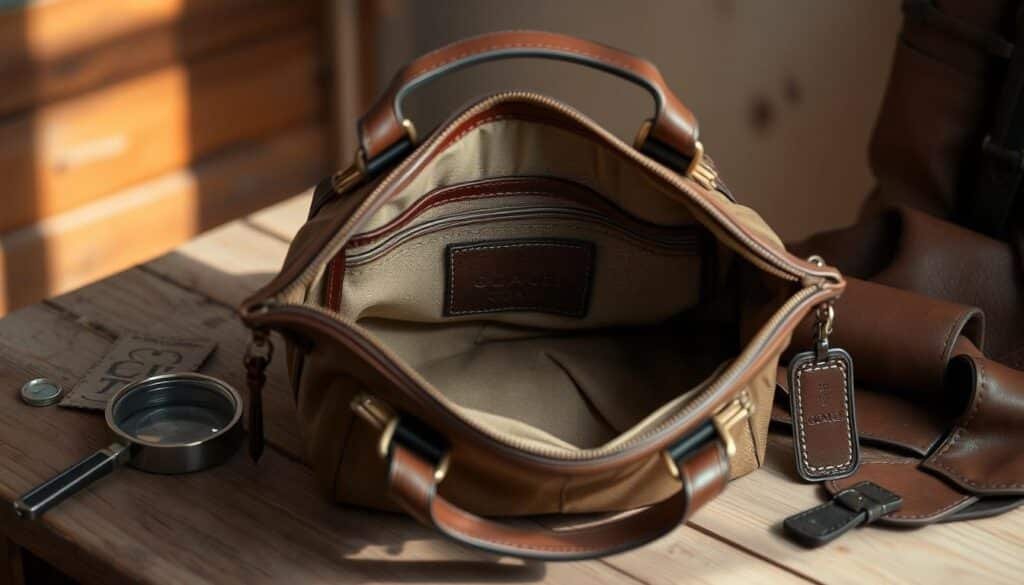To know if a Coach bag is real, check the creed patch for a clear stamp and serial number, inspect hardware for ‘YKK’ zippers, and ensure the ‘C’ pattern is symmetrical.

Table of Contents
- The Telltale Creed Patch: Your First Checkpoint
- Scrutinizing the Hardware: Weight, Markings, and Finish
- Examining the Signature “C” Pattern
- Stitching and Lining: The Devil Is in the Details
- Assessing the Quality of Leather and Materials
- Final Checks: Hangtags, Price, and Seller
- Quick Authentication Checklist
The Telltale Creed Patch: Your First Checkpoint
One of the most reliable indicators of a Coach bag’s authenticity is the interior leather square known as the creed patch. This is not just a label; it is a statement of quality and craftsmanship. In most genuine Coach bags (excluding smaller items like wallets or pouches), you will find this patch stitched neatly inside, typically on the interior pocket.

What Is the Coach Creed?
The creed is a small paragraph of text that speaks to the bag’s origin and the quality of its materials. On an authentic bag, the text is stamped clearly and evenly into the leather, never printed on top. The wording should be sharp, well-spaced, and free of spelling errors. Counterfeit bags often feature messy, uneven text with misspellings or awkward grammar. The paragraph should be centered and justified on the patch.

Analyzing the Serial Number
Below the creed paragraph sits the serial number. This is where many fakes get it wrong. The format of this number has evolved over the years, but it always follows a specific logic.
- Bags Made Before 1994: These vintage bags had a serial number with four to seven digits, containing only numbers. This number was unique to each specific bag.
- Bags Made from 1994 to the early 2000s: The format changed. The number, now often called the “style number,” typically started with a letter (indicating the month of production) followed by numbers that identified the year and the manufacturing plant, ending with the style number. For example, a number like F5D-9966.
- Modern Bags: Today’s bags usually have a number that begins with a letter followed by four or five digits. This is now purely a style number, not a unique serial number. For instance, a number like F58849.
A key mistake on replicas is a nonsensical or overly simple number. Also, be wary if a bag has the famous “creed” paragraph but no serial number below it—this is a significant red flag for bags made after the 1970s.
Quality of the Stamp and Text
Run your fingers over the patch. A genuine creed is debossed, meaning the letters are pressed *into* the leather, creating a crisp and permanent impression. Fakes often have a shallow, poorly defined stamp or, worse, ink-printed text that can feel flat or even rub off. The stitching around the patch should be perfect—straight, even, and without any loose threads.
Scrutinizing the Hardware: Weight, Markings, and Finish
Coach uses high-quality, solid metal hardware that has a noticeable heft. Counterfeit manufacturers cut costs here, resulting in hardware that feels light, cheap, and often coated in a thin layer of plating that can chip or flake.
The Feel and Weight of Metal Components
Pick up the bag and feel the weight of the zippers, turn-locks, and strap buckles. Authentic Coach hardware is typically made of brass or nickel and feels substantial. If the metal components feel light and hollow like plastic, you are likely holding a fake. The finish should be smooth and consistent, not bubbly or pitted.
Zippers: Identifying YKK and Ideal Brands
Coach has a long-standing relationship with premium zipper manufacturers. Check the zipper pull or the slider itself for a subtle engraving. Most authentic Coach bags use zippers from YKK or Ideal. The engraving should be clean and sharp. The absence of a brand name on the zipper is a strong indicator of a counterfeit, as is a zipper that snags or feels flimsy during operation.
Turn-locks, D-rings, and Buckles
Examine any turn-locks or buckles. The iconic “Coach” name, when engraved, should be precise and well-defined. The movement of a turn-lock on a real bag is smooth and secure. On a fake, it might feel loose or difficult to turn. The D-rings that connect the straps should be solid and seamless, not pinched together with a visible gap.
Examining the Signature “C” Pattern
For bags featuring the famous “Signature C” pattern, alignment is everything. Coach’s commitment to quality extends to the precise layout of its logo fabric. This is an area where counterfeiters almost always fail.
Alignment and Symmetry
On an authentic Coach bag, the “C” pattern is perfectly symmetrical and lined up. The pattern should look consistent from every angle. A key detail is that two “Cs” should always face each other, both horizontally and vertically. This creates a distinct, repeating pattern. If you see single “Cs” floating in the pattern or the design is crooked and misaligned, it is a fake.
The Shape of the “Cs”
Pay close attention to the shape of the letters themselves. They should be crisp and well-defined. Importantly, the pattern should be woven into the jacquard fabric, not printed on top of it. If you look closely at a fake, you might see that the “Cs” appear blurry, smudged, or have an inky look, indicating a low-quality printing process.
Stitching and Lining: The Devil Is in the Details
The quality of a bag’s construction is revealed in its seams and interior. Coach prides itself on meticulous craftsmanship, and this is evident in every stitch.
The Consistency of Stitches
Inspect the stitching along the seams, handles, and around the creed patch. On a real Coach bag, the stitching is perfectly even, straight, and consistent in size. There should be a high stitch count per inch, which indicates durability. Fakes often have sloppy, uneven, or widely spaced stitches. You might see double-stitching in some spots or loose threads hanging off the seams—clear signs of poor quality control.
What Should the Interior Lining Look Like?
While vintage Coach bags were famously unlined to showcase the quality of the suede interior, most modern bags have a fabric lining. Authentic linings are typically made of high-quality solid-color twill or sateen. If the bag has a Signature “C” pattern on the outside, it will *never* have a “C” pattern on the inside, and vice-versa. A bag with “C”s on both the exterior and interior is a dead giveaway of a fake. The lining of a counterfeit bag often feels cheap, thin, and crinkly, like a plastic tablecloth.
Assessing the Quality of Leather and Materials
As experts in leather goods, we understand that the soul of any high-quality bag lies in its materials. Coach built its reputation on using supple, durable, full-grain leather that ages beautifully.
The Smell and Feel of Genuine Leather
A genuine leather Coach bag has a rich, distinct leather scent. A counterfeit bag, often made from polyurethane (pleather) or cheap, chemically treated leather, will have a strong chemical or plastic odor. The feel is just as important. Real Coach leather feels buttery, supple, and has natural variations in its grain. A fake will feel stiff, plasticky, and unnaturally uniform in texture.
At Beldturaleather, our passion for genuine full-grain leather informs everything we create. We believe that true luxury lies in the quality of the materials and the skill of the artisan, principles that help us spot a counterfeit from a mile away. When you invest in a quality leather piece, you’re investing in a legacy of craftsmanship.
Inspecting Canvas and Other Fabrics
For canvas or jacquard bags, the material should feel sturdy and durable. The weave should be tight and robust. Counterfeit fabrics often feel thin, flimsy, and are prone to fraying or pilling quickly.
Final Checks: Hangtags, Price, and Seller
Before making a purchase, a few final considerations can save you from a costly mistake.
Are the Hangtags Authentic?
Most Coach bags come with a hangtag, which should match the material of the bag’s trim. A leather bag should have a leather hangtag; a canvas bag may have a leather or fabric one. The “COACH” logo should be clearly stamped or embossed, not just printed. The bead chain it hangs from should be solid and not easily broken. Fakes often use cheap, oversized hangtags made of “pleather” on a flimsy chain.
If the Price Is Too Good to Be True…
While everyone loves a good deal, an absurdly low price is the biggest red flag. Coach bags hold their value reasonably well. If you see a brand-new bag being sold for a tiny fraction of its retail price on a questionable website or at a street market, you can be almost certain it is a counterfeit.
Where Are You Buying From?
Always purchase from an official Coach store, a reputable department store, or a trusted reseller with a strong authentication policy. Be extremely cautious of street vendors, unauthorized online sites, and social media marketplaces, as these are hotbeds for fakes.
Quick Authentication Checklist
Use this table for a fast reference when you are inspecting a potential purchase.
| Feature | What to Look For |
|---|---|
| Creed Patch | Clear, debossed text; no spelling errors; correct serial number format. |
| Hardware | Substantial weight; smooth finish; “YKK” or “Ideal” zipper markings. |
| “C” Pattern | Symmetrical (pairs of Cs face each other); not cut off at seams. |
| Stitching | Even, straight, and consistent; no loose threads. |
| Lining | High-quality fabric; never a “C” pattern inside if it’s on the outside. |
| Leather/Material | Rich leather smell (not chemical); supple feel; durable fabric. |
| Price & Seller | Price is realistic; purchased from a reputable source. |



